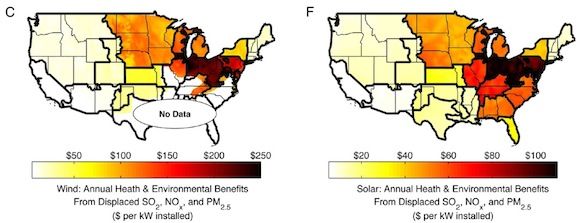The combined health, environmental, and climate benefits of a solar panel in New Jersey are fifteen times greater than those associated with one in Arizona, and a wind turbine in West Virginia displaces twice as much carbon dioxide as the same turbine would in California.
Those are among the surprising results of a new study by Carnegie Mellon University researchers published in the Proceedings of the National Academy of Sciences.
Wind turbines perform best in the Great Plains states and Texas, where capacity factors can exceed 40 percent, but a wind turbine in Ohio or Indiana would primarily displace coal-fired power plants, which cause the greatest health and environmental damage. California already has a relatively clean power generation mix with just 8.2 percent of its total power generated by coal, according to State of California data, almost all of which is imported from other states. So the combined benefits of a wind turbine in Indiana or Ohio would amount to $100 per megawatt-hour, while the benefits of the same turbine in California would be just $13 per megawatt-hour.
Similarly, solar PV performs best in the sunny Southwest, and worst in New England. But by displacing coal, the combined benefits of a solar array in Ohio or New Jersey would be fifteen times greater than those that the same array would provide in Arizona, where clean-burning natural gas is the dominant “marginal” fuel that a solar array would displace.
“If you are interested in mitigating climate change and improving human health, you get significantly greater benefits from wind or solar in places like Pennsylvania, Indiana, or New Jersey,” explains co-author Kyle Siler-Evans.
The benefits vary not only by where wind and solar power is generated, but when. Wind production is generally best at night, so it tends to displace coal-fired “baseload” generators. Solar output peaks at midday, so it is more likely to offset on-demand natural gas generators. As a result, a megawatt-hour of wind energy can displace more emissions than a megawatt-hour of solar energy, depending on where it is installed. Wind delivers 30 percent more benefit than solar in Virginia and Maryland, but the difference is “negligible in much of the country.”
Assigning costs and benefits
To estimate the social and environmental benefits, the researchers assigned costs to the damage caused by each type of emissions from conventional power plants.
To carbon dioxide, they assigned a somewhat arbitrary value of $20 per ton, slightly above the current cost of the broken European Union carbon trading market. (This reflects the difficulty of valuing carbon emissions; various groups have estimated damages at $0 to more than $100 per ton of CO2.)
Emissions of sulfur dioxide, nitrogen oxides, and coarse particulate matter (PM2.5) were taken from the Air Pollution Emission Experiments and Policy (APEEP) analysis model. The researchers used this data to assign average damages for each pollutant by county. Placing a price tag on those emissions largely relied on the $6 million value placed on a premature death from air pollution (the so-called "value of a statistical life”).
The costs were then calculated for each of twenty-two regions of the country, based on actual EPA hourly emissions data for 1,400 fossil-fueled power plants from 2009 through 2011. (Downloadable data used in the researchers’ calculations is available here.) Nuclear, hydroelectric, and some other generators were excluded from the analysis because they were not likely to be displaced by solar or wind. PM2.5 emissions data were taken from an annual data set from the 2005 National Emissions Inventory, and distributed proportionally by power output to arrive at hourly figures.
To determine the benefits of solar and wind generation, the researchers used wind data for more than 33,000 locations across the United States to calculate the potential generation of a Vestas 3-megawatt wind turbine in each location. Similarly, they used solar data for more than 900 locations to estimate the output of a hypothetical 13 percent efficient, 1-kilowatt solar panel facing south with a tilt equal to each site’s latitude.
With this data, the researchers were able to estimate the avoided damages for each wind turbine and solar panel according to the conventional power generation it would displace in any given hour in each region.
Policy implications
One of the policy implications of the research is that subsidies for wind are “a good value for taxpayers”: For every megawatt-hour generated from wind, the Production Tax Credit costs taxpayers $22 but delivers $35 in benefits, primarily by avoiding emissions of sulfur dioxide and carbon dioxide. If carbon dioxide were valued at $30 per ton instead of $20, those emissions alone would justify the cost of the tax credit for existing wind farms, the researchers say.
But perhaps those subsidies should be allocated to where they’ll do the most good. With a range of $10 to $100 per megawatt-hour, depending on location, it should be possible to tune incentives to get more benefits for the buck. “Remarkably, if the goal is to improve air quality and human health, Arizona and New Mexico are among the worst locations for solar,” the study observes.
Study co-author Inês Azevedo, a professor of engineering and public policy at CMU, elaborates: “Instead of valuing kilowatt-hours, [if] the policy mechanism…looked at metric tons of carbon dioxide avoided and health and environment damages avoided, we’d find that wind is oversubsidized in California and undersubsidized in Pennsylvania.”

Figure: Locations where wind and solar will do the most good, according to the researchers
Location is key, not only for the type of conventional power generation displaced by renewables, but for the number of people affected.
“Coal plants in the East are particularly harmful owing to their proximity to major population centers,” the study notes.
Siler-Evans explains: “These areas provide more benefits because they displace coal plants that are upwind of major population centers.”
Another implication is that carbon pricing, while a popular approach to mitigating climate change, really only addresses one part of the problem. Removing threats to human health should be at least as much a priority as halting global warming. So targeting incentives to displace the most coal power could deliver greater benefits by reducing sulfur dioxide, nitrogen oxide, and PM2.5 emissions, not just carbon dioxide.
The findings also imply that wind and solar generation could be properly valued at nearly twice the price of conventional grid power, changing the notion of “grid parity” and casting renewable subsidies in an entirely different light. “We estimate in this paper that in certain regions that wind or solar provides about 10 cents a kilowatt-hour in social benefits, and so if you were to credit wind or solar with those benefits -- give them money for the benefits that they provide -- it would hugely change the economics,” Siler-Evans said.
But while these are all useful insights, one wonders how to actually translate them into policy in a country where the very existence of incentives is continually under attack. Optimizing them for the greatest health and environmental benefits would place another layer of complexity on an industry that is already horrendously complex and rife with challenges when it comes to integrating more renewable power.
Perhaps a “benefit index” should be derived from this research, assigning a number to each location in the U.S. Policymakers could use those numbers to identify where wind and solar will do the most good, and to generate support for it in their communities. Identifying specific populations whose health will benefit from replacing coal power plants would certainly have longer political legs than the seemingly vague and distant threat of climate change.
The study offers a useful starting point for properly valuing renewable power generation, particularly for policy purposes. But we would argue that the benefits are probably understated, because the efficiency of wind turbines and solar power is improving all the time.
GE’s latest “brilliant” wind turbine is more productive at low wind speeds than the Vestas V90 3 MW turbine modeled in the study. Newer solar modules are achieving efficiencies of 18 percent to 22 percent, well above the 13 percent efficiency of the hypothetical module used in the study. And with the addition of storage capacity, existing wind and solar installations could displace even more generation from power plants fueled by natural gas as well as coal.
***
Chris Nelder is an energy analyst and consultant who has written about energy and investing for more than a decade. He is the author of two books (Profit from the Peak and Investing in Renewable Energy) and hundreds of articles, and has been published by Scientific American, Slate, the Harvard Business Review blog, Financial Times Alphaville, Quartz, the Economist Intelligence Unit, and many other publications.



